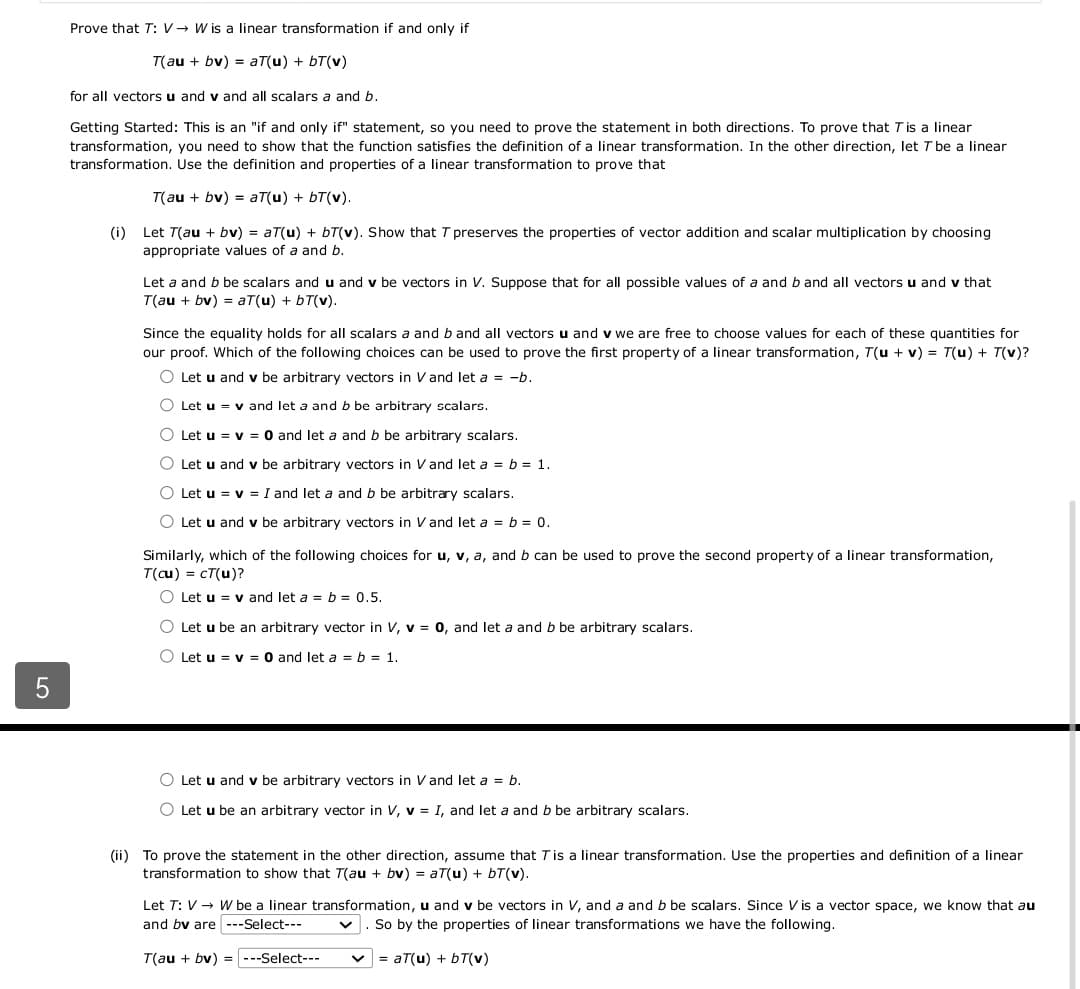Prove that T: V→ W is a linear transformation if and only if T(au + bv) = aT(u) + bT(v) for all vectors u and v and all scalars a and b.
Prove that T: V→ W is a linear transformation if and only if T(au + bv) = aT(u) + bT(v) for all vectors u and v and all scalars a and b.
Linear Algebra: A Modern Introduction
4th Edition
ISBN:9781285463247
Author:David Poole
Publisher:David Poole
Chapter6: Vector Spaces
Section6.4: Linear Transformations
Problem 24EQ
Related questions
Question

Transcribed Image Text:5
Prove that T: V→ W is a linear transformation if and only if
T(au + bv) = aT(u) + bT(v)
for all vectors u and v and all scalars a and b.
Getting Started: This is an "if and only if" statement, so you need to prove the statement in both directions. To prove that T is a linear
transformation, you need to show that the function satisfies the definition of a linear transformation. In the other direction, let T be a linear
transformation. Use the definition and properties of a linear transformation to prove that
T(au + bv) = aT(u) + bT(v).
(i) Let T(au + bv) = aT(u) + bT(v). Show that T preserves the properties of vector addition and scalar multiplication by choosing
appropriate values of a and b.
Let a and b be scalars and u and v be vectors in V. Suppose that for all possible values of a and b and all vectors u and v that
T(au + bv) = aT(u) + bT(v).
Since the equality holds for all scalars a and b and all vectors u and v we are free to choose values for each of these quantities for
our proof. Which of the following choices can be used to prove the first property of a linear transformation, T(u + v) = T(u) + T(v)?
O Let u and v be arbitrary vectors in V and let a = -b.
O Let u v and let a and b be arbitrary scalars.
O Let u = v= 0 and let a and b be arbitrary scalars.
O Let u and v be arbitrary vectors in V and let a = b = 1.
○ Let u = v= I and let a and b be arbitrary scalars.
O Let u and v be arbitrary vectors in V and let a = b = 0.
Similarly, which of the following choices for u, v, a, and b can be used to prove the second property of a linear transformation,
T(cu) = cT(u)?
O Let u = v and let a = b = 0.5.
O Let u be an arbitrary vector in V, v = 0, and let a and b be arbitrary scalars.
O Let u = v= 0 and let a = b = 1.
O Let u and v be arbitrary vectors in V and let a = b.
O Let u be an arbitrary vector in V, v = I, and let a and b be arbitrary scalars.
(ii) To prove the statement in the other direction, assume that T is a linear transformation. Use the properties and definition of a linear
transformation to show that T(au + bv) = aT(u) + bT(v).
Let T: V → W be a linear transformation, u and v be vectors in V, and a and b be scalars. Since V is a vector space, we know that au
and bv are ---Select---
So by the properties of linear transformations we have the following.
T(au + bv) = ---Select---
= aT(u) + bT(v)
Expert Solution
This question has been solved!
Explore an expertly crafted, step-by-step solution for a thorough understanding of key concepts.
This is a popular solution!
Trending now
This is a popular solution!
Step by step
Solved in 2 steps with 2 images

Recommended textbooks for you

Linear Algebra: A Modern Introduction
Algebra
ISBN:
9781285463247
Author:
David Poole
Publisher:
Cengage Learning

Elementary Linear Algebra (MindTap Course List)
Algebra
ISBN:
9781305658004
Author:
Ron Larson
Publisher:
Cengage Learning

Linear Algebra: A Modern Introduction
Algebra
ISBN:
9781285463247
Author:
David Poole
Publisher:
Cengage Learning

Elementary Linear Algebra (MindTap Course List)
Algebra
ISBN:
9781305658004
Author:
Ron Larson
Publisher:
Cengage Learning